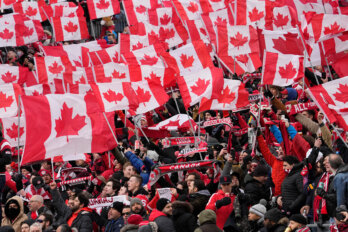It’s the ninth inning, in the middle of a humdrum September, and Roberto Osuna makes his way to the pitcher’s mound. Toronto is facing the Minnesota Twins in their 148th Major League Baseball game of the year—the latest in the sport’s annual ritual of meaningless matches played by a bad team going nowhere.
Osuna steps on the rubber for his first warm-up in more than a week; he’s just rejoined the team after the birth of his first child, a daughter. He’s wearing his trademark scraggly goatee, braces twinkling in the floodlights, more high-school jock than professional pitcher. Both teams are surprised. The Twins, once thought to be among the league’s worst, are now clinging to the final playoff position, thanks to a combination of youth and veteran leadership. The Blue Jays, in last place, are up 4–3 tonight, a welcome reprieve for a team recovering from two fresh losses. In these situations, Toronto manager John Gibbons has only one pitcher he trusts to close out the game: Osuna.
For much of this season, Osuna’s performance has reflected the twenty-two-year-old’s charmed life in baseball. Osuna’s father was a ballplayer and spent twenty years pitching in the Mexican leagues. When his body gave out from the stress, he could no longer support his already struggling family of six—all of whom shared a single bed. Osuna, then a chubby twelve-year-old, left school for the fields to help his father work. Academic education didn’t matter to him anyway. Baseball was his only dream. That year, a scout saw him throw a ball, and Osuna found his way to a tournament in Japan, a preteen playing against boys eight years older. He’d get paid under the table and send the cash back home. By the time he turned fourteen, he was hitting 90 mph on the radar gun.
That fastball vaulted Osuna from the tomato fields of Sinaloa, Mexico, to stardom in Toronto. A talented but little-known prospect, he made the Blue Jays at the age of twenty, in the spring of 2015. By June, he had taken on the job of closer, a rookie parachuted into baseball’s most torturous role. The closer pitches almost exclusively at the end of a close game, precisely when there is the most to lose.
When Osuna joined the Blue Jays, though, the team hadn’t been to the playoffs in more than twenty years. The closing pressure was there, but it felt lighter. Losing close games had become company policy. But then the team made those key trades, first for Troy Tulowitzki and then David Price, that exhilarated the roster and the city. Suddenly, the Blue Jays were unbeatable, a collection of talented castoffs coming together for one final push. The world’s eyes fell on Toronto to watch José Bautista and Josh Donaldson mash the ball all the way to first place. And then, at the end of each game, the veteran roster would put their faith in the league’s youngest player.
Osuna seemed impervious, sealed off from the vicissitudes of the game. In his play, he was fearless and daring, conquering each game at its apex, and his unwavering focus would cede in victory to childlike joy. In his public persona, though, he was reserved, shading himself under the giant personalities of his brash teammates. If it was a strategy, it worked. He was sensational: his cutters and sinkers biting at the ankles of batters who would just swing through a puff of dust like children with their first Wiffle Ball. For two straight years, he held the job, and for two straight years, he was practically flawless—sitting down batters with a machine-like rhythm. It seemed like he’d never break. Until, suddenly, he did.
A slump is one of the most baffling disorders in sports. There are rarely any symptoms to warn that it’s coming. A player doesn’t know when one bad game will become three or ten. Most frustratingly, they can’t know when it will end. At that point, the athlete will try anything to change their luck. They’ll tinker with their motions in case the problem is physical, though it almost never is. They’ll cut their hair or switch their shoes in an appeal to karma. That won’t work either. Eventually, the athlete will realize that battling the inexplicable is futile.
A slump also challenges one of the most dramatic ways baseball has changed in the past decade—a transformation familiar to anyone who’s read Michael Lewis’s Moneyball. Data analytics, also called sabermetrics, have turned players into living mathematical expressions. Want to know a player’s true value? Look at their wins above replacement, a single statistic that quantifies a player’s total worth by grading every facet of his performance—calculating it generates equations that would look comfortable on a whiteboard at MIT.
Through such analysis, teams have been able to predict success and track unseen advantages with an efficiency unimaginable just a few years ago. The defensive shift, for example, is a tactic in which teams move fielders to a place a specific batter is more likely to aim toward—which is why a shortstop might find himself in right field. The practice has been around for more than 100 years, but, between 2011 and 2015, as we gathered more data on individual hitters, use of the shift increased over 1,200 percent. Teams and fantasy-sport participants alike obsess over such stats, leading both franchise and fan to think of baseball as a collection of numbers.
Sabermetrics, however, often overlook the best part of baseball: at its core, it’s an immensely human game. To separate the sport from mortal fallibility is like converting Monet’s paintings into black and white; the artist’s ochres and creams, his soft pinks, blues, and reds are not minor details: they’re the whole point. Our fixation on athletes as collections of data points, in other words, has led us to forget the colour in the game—that the sport is played by young men, prone to insecurity and destined for occasional failure. In large samples, data unearth precious truths previously hidden. But playoff berths can be won and lost over a couple weeks, and championships in just days. In those timelines, baseball is ruled by the unquantifiable randomness of physical performance.
On June 23 of this year, the Blue Jays were playing in Kansas City. Osuna held his place amongst the best in baseball—when he pitched, the Blue Jays won. On this night, the team had built a 4–1 lead, going into the bottom of the ninth. Naturally, it was time for “Osuna Matata.” But Osuna didn’t come running from the bullpen door; he was watching from the dugout. The Jays blew the game, and everyone wondered what was wrong with Roberto.
Afterwards, with the cameras rolling, Osuna did a strange thing: he told the truth. “I’m just feeling a little anxious, a little weird,” he told reporters, “I’m just not myself.” The implications were troubling—was he dealing with mental illness? He never said so and neither did any doctor, but fans and critics alike clung to the assumption. Amazingly, the reaction was overwhelmingly positive. Writers admitted their own mistakes in sympathy; fans wrote messages in support. Osuna had taken a risk: mental health is not always given nuanced treatment in sports. Royce White is a basketball player, drafted by the Houston Rockets in the first round of the 2012 NBA draft. He was candid about his anxiety disorder. Today, he’s playing in London, Ontario.
So Osuna sat and tried to get better. He leaned on catcher Russell Martin, his mentor, and pitcher Jason Grilli, whom he calls a second father. And then, two days after he made the admission, he came back, and he pitched well, and he was named an all-star. Everything, it seemed, was back to normal.
After the all-star break in mid-July, the Blue Jays struggled, and the season teetered toward insignificance. They cut Grilli. Residual excitement from the success of the previous two seasons hid an unfortunate truth: this team, old and injured, was still deeply flawed. The mediocrity was catching: Osuna fell apart. His cutter was floating, his fastball finding opponents’ bats. He’d blow game after game, always, it seemed, with two outs and only one to go. Martin got hurt, and Osuna’s struggles intensified.
People wondered if Osuna was okay. It wasn’t clear he could be trusted. The thing about baseball is, at any given point, the game extends endlessly. If you’re protecting a lead in hockey or soccer, the game is finite and terminal: all I have to do is hold on for five more minutes, three more minutes, thirty seconds. In baseball, where time is not a barrier, there is no such relief. The closer, then, is faced with a crushing reality: when the game starts to unravel, there is nothing and nobody but him to stop it.
Self-belief and swagger were the dominant characteristics of this Blue Jays team—the team that rumbled through to the American League Championship Series in 2015 and 2016 and entered the 2017 season primed for another run. This crew welcomed a generation of young Torontonians into baseball by embodying Toronto’s prevailing civic myth: that the city is made up of outsiders railing against orthodoxy, beating down the gates of the elite. Unyielding and unapologetic, the team reflected our best self. The more that opposing teams came to hate them—which they did—the more we loved them.
That’s why this year has been so startlingly sad. It isn’t simply that the Blue Jays have lost, Toronto sports fans are used to that, it’s that the confidence that once galvanized the team is gone. In its place was listless play, bordering on disinterest. But not all poor performances can be judged equally. A hitter gone cold can be insulated by the rest of the lineup, and veterans have learned how to move on from failure. For the young Osuna, it was different. The closer is a trapeze artist, reaching to catch his partner: when he misses, the results are immediate, public, and violent.
So as Osuna led the league in blown save opportunities, fans watched with equal parts horror and fascination. The young man was going through his first lasting major-league slump and was doing so without his support system of Martin and Grilli, away from his family and unborn child, and while working through his own battle with anxiety. Throughout it all, he was honest and thoughtful. “Physically? No issue, feeling great,” he said in August. “I can’t understand. I don’t have words. It’s happening so fast.”
As in life, losing reveals. You learn the most about an athlete when nothing is going right for them. Some of the Blue Jays folded this summer, electing to ride out a moribund year. But Osuna, at twenty-two, kept coming back.
With two outs in the bottom of the ninth in the September game against Minnesota, Kennys Vargas steps up to bat. Osuna toes the mound and stares ahead at his catcher, Martin, who’s behind the plate for the closer.
Osuna puts away the first two batters of the inning easily, first with a groundout and then with a short fly ball. He pumps a fastball past Vargas but follows it up with three straight balls; a telltale sign of a pitcher who’s lost control. On the fifth pitch, he puts a fastball right down the middle. Vargas fouls it off. On a full count, the pitcher reaches back and propels another 97 mph fastball towards the plate. Vargas swings through, and the game is over. Blue Jays win.
Martin jogs towards the mound and hugs his friend. He looks relieved. There’s no way to predict when an athlete in freefall will find his footing. The only proven remedy is time. What makes a slump just a slump, after all, is that it ends.






